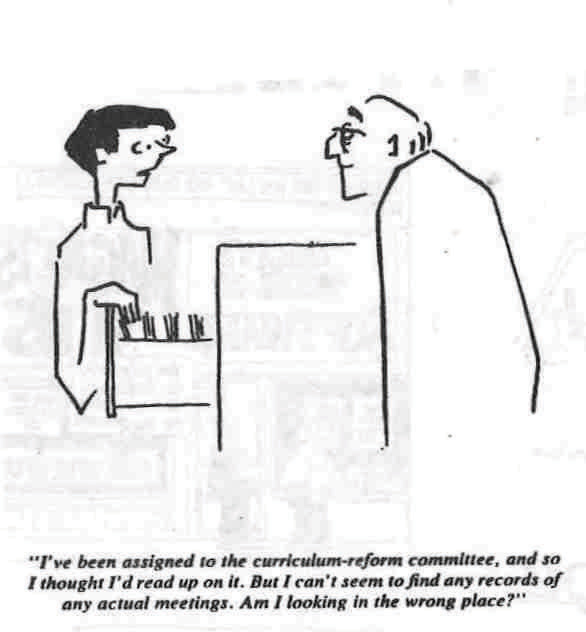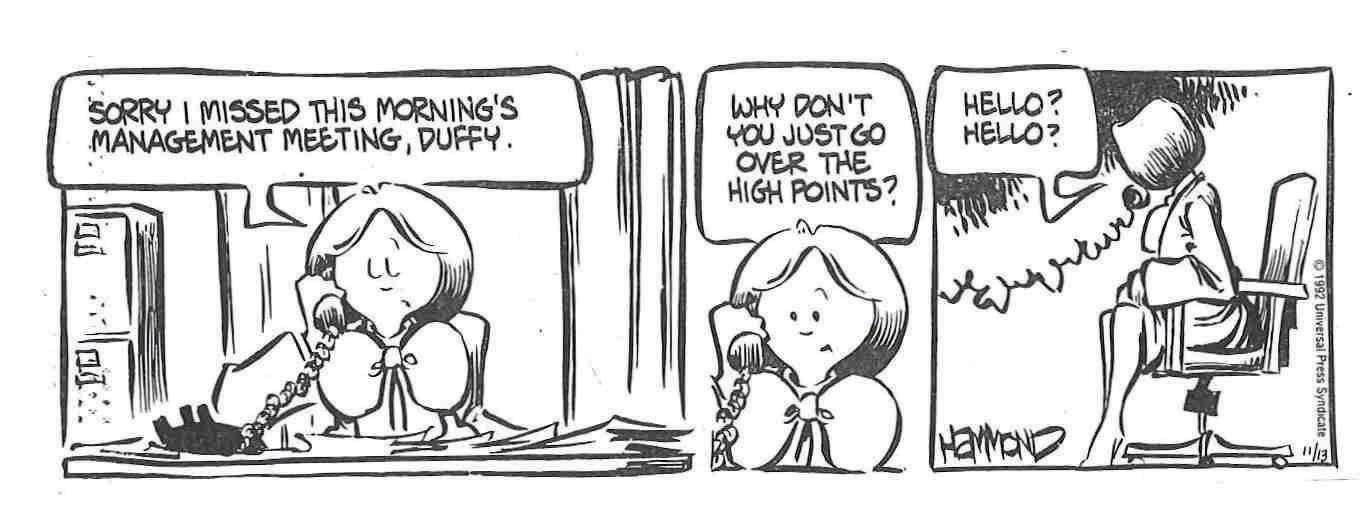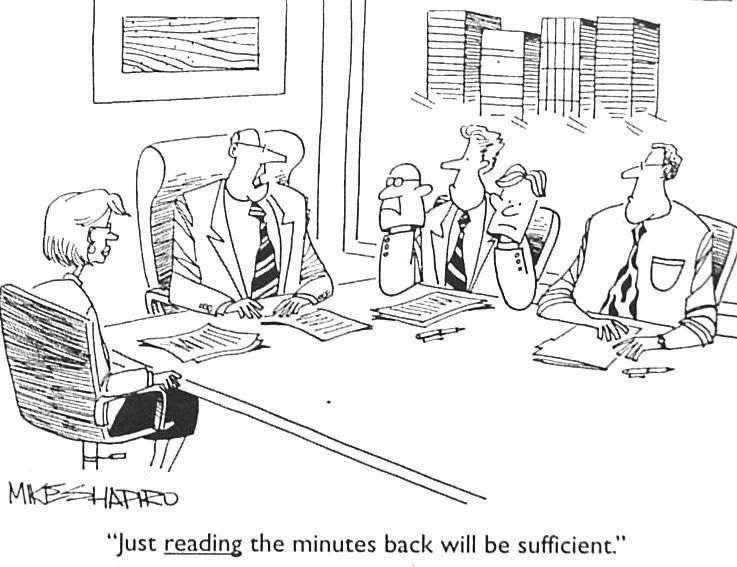This is “Post Meeting Communication and Minutes”, section 12.4 from the book An Introduction to Group Communication (v. 0.0). For details on it (including licensing), click here.
For more information on the source of this book, or why it is available for free, please see the project's home page. You can browse or download additional books there. To download a .zip file containing this book to use offline, simply click here.
12.4 Post Meeting Communication and Minutes
PLEASE NOTE: This book is currently in draft form; material is not final.
Learning Objectives
- Identify a tool for recording and preserving notes of professional group conversations.
- Acquire a format for minutes which emphasizes actions taken by a group and the people assigned to accomplish them.
- Identify three ways in which a good group leader should follow up on meetings of the group.
Bookends hold books up. Without them, the books tumble onto each other or off the shelf. The “bookends” of a meeting, likewise, are as important as the meeting itself. Without them, nobody knows beforehand what’s going to happen or remembers afterward what did.
We’ve discussed the first major bookend of a meeting, its agenda. In this section we’ll turn our attention to the kinds of bookends that follow a meeting, including principally its minutes.
One Administrative Tool
A college administrator we know developed a form to give people after any conversation they had in his office, much less a formal meeting. He would take notes on the form of what he and the other people in the conversation said, and especially of what they agreed or disagreed on at the end of their meeting. Then he would share the notes with the other people, make a photocopy for each, and have them all initial their copies. Why? Because the administrator knew that busy people may quickly forget exactly what they decided in a conversation, or even what they talked about, unless they keep a shared record of what happened. Whether we like or believe it or not, our individual impressions of a meeting start changing and diverging the moment we leave the site. As one business writer noted, “Even with the ubiquitous tools of organization and sharing ideas…the capacity for misunderstanding is unlimited.”Matson, E. (1996, April-May). The seven sins of deadly meetings. Fast Company, 122.

The Why and How of Minutes
Among the exasperating experiences in group meetings are moments when people say, “We talked about this before—at least twice. Why are we going over the same ground again?” There are also those times when we hear, “John, you were supposed to report on this. What’s your report?” and John replies, “But I didn’t know I was supposed to make a report.”
The best way to prevent such deflating episodes is to follow up after each meeting with good records. Here are two ways to do this:
- Keep ironclad minutes. One college in Washington State has used this template for many years to shape and retain minutes of its academic committee meetings:
Date/time/location of meeting: ____________________________________
Purpose/goals of meeting: ____________________________________
Person presiding: ____________________________________
Officers in Attendance: ____________________________________
Other members in attendance: ____________________________________
Members absent: ____________________________________
Table 12.1 Agenda Template
| Agenda Item | Discussion/Motions | Action Taken | Follow-Up |
|---|---|---|---|
| 1. Minutes | Approved as printed. | ||
| 2. Agenda | Approved as disseminated 5/29/2013. | ||
| 3. Roof problem | John Smith reported that the ceiling in the staff washroom leaks. Motion by Mary Jones to have the ceiling repaired; motion passed. | Plant/Maintenance will be asked to patch the leak. | John Smith will contact Jane Doe, head of Plant/Maintenance, by 6/15 to schedule repair. |
Time of adjournment: ____________________________________
Date/time/place of next meeting: ____________________________________
Notice that this style of minutes lacks extensive text and “he said/she said” descriptions.

Instead, it makes crystal clear who’s responsible for what actions prior to the next meeting. Its contents are brief, easy to read, and very difficult to misinterpret (or evade). It promotes action and accountability.
-
Distribute minutes promptly. When and how you disseminate minutes shows whether and how much you care about what your group does. If your group has bylaws, it may be a good idea for them to include a time frame within which minutes of meetings need to be distributed (such as “within five days”).

Make sure your mailing list of people to receive minutes is up to date and accurate. This will ensure that no one misses the next meeting because he or she didn’t see when and where it was scheduled to take place.
Sloppy minutes degrade the value of the work and time people invest together. They can also weaken a group’s morale. Professional minutes, on the other hand, may even make people who weren’t at a meeting wish they had been—although that’s perhaps asking a lot, unless you served pizza!—and can strengthen your group’s pride and solidarity.
What Else?
If you’re the leader of the group, making sure that minutes are prepared and distributed well is only one step toward increasing the likelihood that your meetings will achieve their full potential of transmitting discussions into plans and plans into action. You should do three other things after a meeting.
First, you should contact group members who were identified in the minutes as being responsible for follow-up action. See if they need information, resources, or other help to follow through on their assignments. If a committee or subcommittee was asked to take action on some point, get in touch with whoever heads it and offer to provide materials or other support that may be needed to accomplish its work.
Second, you should set a positive example. Take a few minutes to reflect on how effective you were in facilitating the last meeting and ask yourself what you might change at the next one. Be sure, too, to implement any decisions in a timely fashion that you as the leader were given.
Third, you should make sure that the minutes of your group’s meetings are stored in secure form, either physically or digitally or both, so that they are available to both you and other group members at any time. Your group’s institutional memoryShared remembrances among members of a group, which may or may not be recorded in physical form, of the group’s past., which is the foundation for future members to build upon, needs to be tended regularly and diligently. When in doubt, it’s better to hold onto information and documentation related to your group. Discarding something because you think to yourself “nobody will forget this” may very well turn out to be a mistake.
Observing these suggestions may not make the experiences associated with following up on group meetings heavenly, but it might at least keep them from being too hellish.
Key Takeaway
- After a group meets, its leader should ensure that professional minutes are disseminated and that other members of the group follow through with their responsibilities.
Exercises
- Pay special attention to conversations you carry on over the next several days in school and at home. Pick one of them and write simulated minutes according to the format shown in this section. What did you learn from this process about distilling and summarizing information from oral interactions?
- Locate a website of an academic, business, or civic organization which includes minutes of a recent meeting by some of its members. Identify portions of the minutes that you feel would enable you as a member of the group to adequately understand an important action taken by the group if you were unable to attend the meeting. If you were part of the group, what improvements would you make in the format of its minutes to further enhance their effectiveness?




